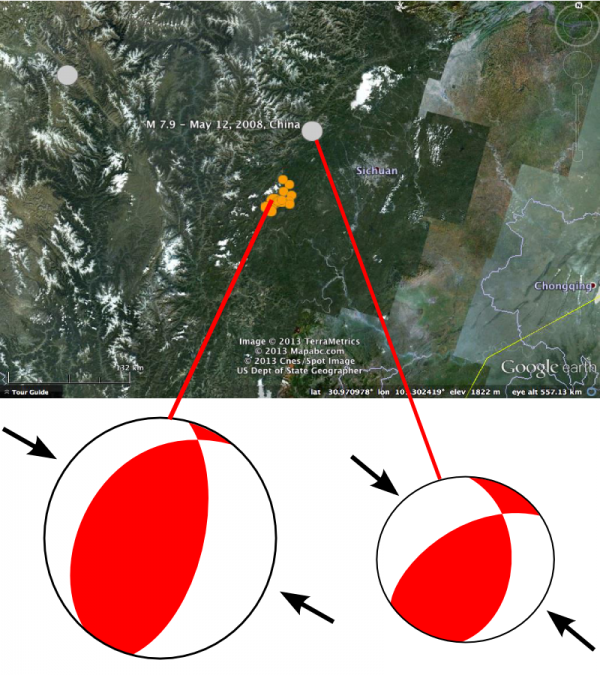![]() On Saturday morning local time (Friday evening for us in the USA), a magnitude 6.6 earthquake shook up Sichuan province in western China, about 35 km north of the closest city, Ya’an, and 115km west of the provincial capital Chengdu. Its shallow depth (about 12 km, according the USGS), meant strong shaking above the rupture; so far more than 150 deaths have been reported, with hundreds more injured. This BBC report includes footage of the shaking and collapsed buildings.
On Saturday morning local time (Friday evening for us in the USA), a magnitude 6.6 earthquake shook up Sichuan province in western China, about 35 km north of the closest city, Ya’an, and 115km west of the provincial capital Chengdu. Its shallow depth (about 12 km, according the USGS), meant strong shaking above the rupture; so far more than 150 deaths have been reported, with hundreds more injured. This BBC report includes footage of the shaking and collapsed buildings.
This is the same region that was shaken by the much larger magnitude 7.9 Wenchuan earthquake on May 12 2008, resulting in tens of thousands of deaths; in fact, that rupture was less than 100 km north-northeast of this latest one. When added to the fact that the focal mechanisms for both earthquakes are also very similar, indicating WNW-ESE compression on a NNE-SSW trending fault, this relative location makes it likely that we are seeing a further rupture of the same fault system that failed in the Wenchuan earthquake – either an adjacent segment of the same fault, or another, similarly oriented fault in the same thrust system.

Location and focal mechanism for M 6.6 earthquake on 20th April 2013 in Sichuan Province China (orange dots include first 12 hours of aftershocks) and the May 2008 M 7.9 Wenchuan earthquake (grey dot). Data from USGS.
The ultimate cause of this earthquake is the continental collision that has produced the Himalayan mountains to the east. As India continues to push into Asia, some of the Asian crust is pushed out of the way upwards, creating the looming heights of the Himalayas and the Tibetan plateau; but some is also being pushed out of the way sideways in the direction of China. The Longmenshan mountains, where all this seismicity is occurring, mark a place where there is a particularly strong bit of Chinese crust – the Sichuan Basin – standing against this tectonic invasion, forcing the eastwards migrating crust to be thrust over it. For more details and some nice explanatory figures, check out Kim Hannula’s post on the tectonics of the 2008 earthquake.
The other question to consider is whether the Wenchuan quake was an influence om the timing and location of this latest rupture. In a discussion on Twitter Eric Fielding pointed me to this July 2008 paper by Parsons et al. that calculated the permanent stress changes on neighbouring and nearby fault segments induced by the Wenchuan rupture: they concluded that it caused the stress to increase on both the southern continuation of the Wenchuan Fault itself, and the parallel Ya’an Thrust that may be a better candidate for the source of the current shaking.

A tectonic map of the Longmenshan thrust system. The accompanying cross-sections of other faults in the area show modelled increases (red) and decreases (blue) in permanent stress resulting from the 2008 M 7.9 Wenchuan earthquake (white star). Orange boxes highlight the southern segment of the Wenchuan Fault and the Ya’an thrust – both possible sources of the latest quake, whose rough location is shown by the orange circle. Modified from Parsons et al., 2008
This makes it possible that events in 2008 did indeed prime the pump for an earthquake 5 years later, in the sense that it added a little bit of extra stress onto the fault that ruptured last night, and caused it to fail earlier than it would have otherwise. However, the reason that there was a stressed fault ready to fail in the first place is the wider tectonic forces associated with the Himalayan collision.



Links (2)-
-
Pingback: The intrusion of nature | Highly Allochthonous
Pingback: The dimensions of natural disasters | Highly Allochthonous